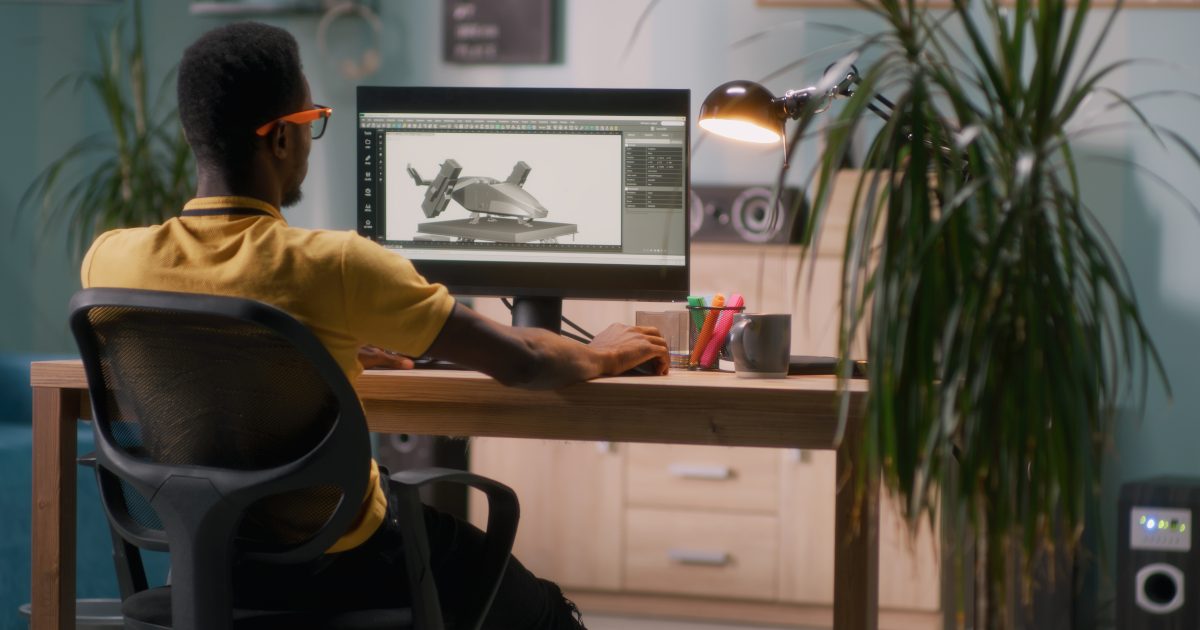3D modeling and Computer-Aided Design (CAD) are powerful tools used across industries like architecture, engineering, product design, and animation. Whether you’re a beginner or an experienced professional, your laptop can be an essential part of your creative workflow. In this post, we’ll guide you through how to use your laptop for 3D modeling and CAD, including the tools you need, how to set up your laptop, and tips for optimizing your workflow.
1. Choose the Right Laptop for 3D Modeling and CAD
Before diving into the software, it’s important to ensure your laptop meets the necessary hardware requirements for efficient 3D modeling and CAD work. Below are the key specifications you should look for:
Key Specifications:
- Processor (CPU): A multi-core processor like Intel Core i7 or higher, or AMD Ryzen 7, is ideal for handling complex 3D models and simulations.
- Graphics Card (GPU): A dedicated GPU like NVIDIA GeForce GTX or RTX, or an AMD Radeon RX series will greatly improve rendering speeds and visuals. Look for laptops with NVIDIA Quadro or AMD Radeon Pro if you need workstation-level performance.
- RAM: At least 16GB of RAM for handling large models and simulations, though 32GB is preferable for heavy tasks.
- Storage: Solid-State Drive (SSD) for faster loading times. Aim for at least 512GB SSD, though 1TB is ideal for larger files.
- Display: A high-resolution display (1080p or higher) with color accuracy is essential for precision work. A larger screen (15–17 inches) can make a big difference in your workflow.
Recommended Laptops for 3D Modeling and CAD:
- Dell XPS 15
- Apple MacBook Pro 16-inch
- Razer Blade 15
- HP ZBook Studio G7
- MSI WS65
2. Install the Right Software for 3D Modeling and CAD
Once your laptop is ready, it’s time to install the software that will help you create 3D models and CAD drawings. Here are some of the most popular programs:
For 3D Modeling:
- Blender: Free, open-source software with powerful modeling, sculpting, and animation features. Ideal for artists and animators.
- Autodesk Maya: A professional 3D modeling, animation, and rendering tool. Widely used in animation and game design.
- Cinema 4D: Great for motion graphics and design. Known for its user-friendly interface and ease of use.
- ZBrush: Specializes in digital sculpting and is widely used for character modeling and detailed work.
For CAD:
- AutoCAD: One of the most popular CAD programs, AutoCAD is used for 2D and 3D drafting in architecture, engineering, and construction.
- SolidWorks: Ideal for product design, particularly mechanical and industrial engineering. It’s known for its parametric design capabilities.
- SketchUp: A user-friendly program perfect for architectural design and simple 3D modeling tasks.
- Fusion 360: A cloud-based CAD, CAM, and CAE tool for product design and engineering. Great for collaborative work.
3. Set Up Your Laptop for Optimal Performance
To ensure your laptop runs 3D modeling and CAD software efficiently, follow these tips:
Update Drivers and Software
- Graphics Card Drivers: Ensure you’re using the latest GPU drivers for optimal rendering and performance. You can update your drivers directly from the NVIDIA or AMD website or through your laptop’s device manager.
- CAD/3D Software Updates: Regularly check for software updates to access new features, bug fixes, and optimizations.
Optimize Your Laptop’s Performance
- Close Unnecessary Programs: Running other apps while working on 3D modeling can slow down your laptop. Close anything you don’t need to free up system resources.
- Enable High-Performance Mode: On Windows, go to Control Panel > Power Options and select High Performance to prioritize power for 3D modeling.
- Manage Storage: Store your project files on an SSD for faster load times, and ensure you have enough space for large 3D files and renderings.
External Monitor (Optional)
For a better viewing experience, consider connecting your laptop to an external monitor. This allows for a larger workspace and can help with detail work when modeling or designing.
4. Tips for Efficient 3D Modeling and CAD Work
Use Keyboard Shortcuts
Most 3D modeling and CAD programs have customizable keyboard shortcuts that can improve your workflow. Learn the most common shortcuts for your software to speed up the process.
Leverage Layers and Groups
Organize your work by grouping objects and using layers. This will make it easier to manage complex models and find specific elements when working on a project.
Save and Backup Your Work Regularly
3D modeling and CAD projects can be complex and take hours to complete. To avoid losing your progress, use cloud storage or an external hard drive to back up your work regularly.
Use Templates and Libraries
Many software programs come with pre-built templates, components, or design libraries. Take advantage of these to save time on repetitive tasks.
5. Rendering and Final Touches
Once you’ve completed your 3D model or CAD design, it’s time to render your project. Rendering turns your model into a realistic image or animation. Here are a few rendering tips:
- Test Renders: Before doing a final render, do smaller test renders to check lighting, textures, and other elements.
- Optimize Render Settings: Adjust settings like resolution and lighting to balance quality and rendering time. On laptops with powerful GPUs, you can experiment with higher-quality settings.
- Consider Cloud Rendering: If your laptop’s hardware isn’t fast enough, consider using cloud rendering services like Autodesk A360 or RebusFarm for faster rendering times.
6. Final Thoughts
Using your laptop for 3D modeling and CAD can be a productive and creative process with the right hardware and software. Whether you’re designing a product, creating 3D art, or drafting engineering plans, following the steps outlined above will help you get the most out of your laptop.
For more tips on optimizing your tech setup for design and engineering, visit Psero.com for expert insights and recommendations!

